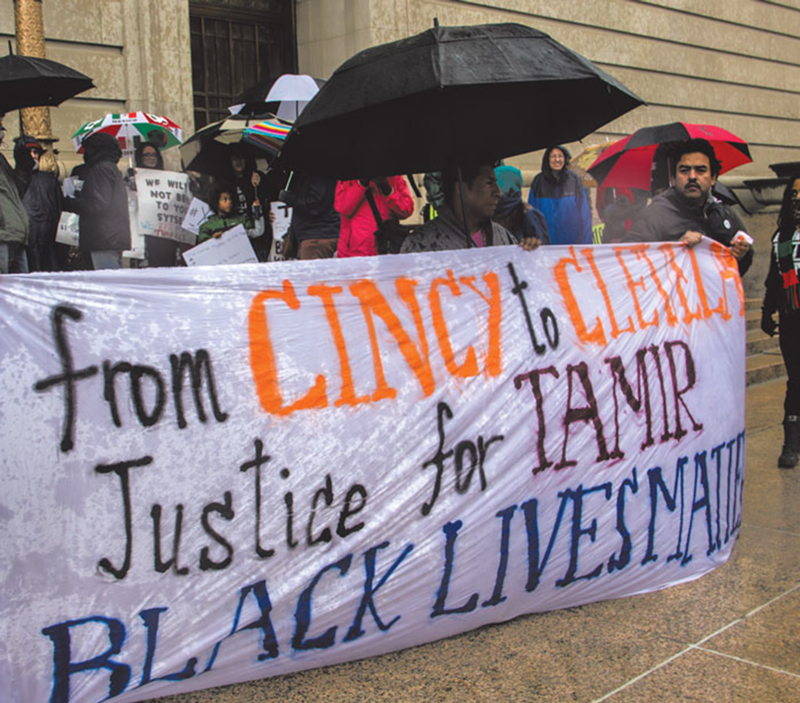Cleveland police officers involved in the shooting of 12-year-old Tamir Rice will not face criminal charges related to the child’s death, the Cuyahoga County Prosecutor’s Office announced today.
A grand jury has been deliberating for months about the case, which has grabbed national attention as debate continues over police-involved shootings of people of color.
Rice was shot Nov. 22, 2014 while on a playground in Cleveland. A 911 caller reported that Rice was playing with a handgun, but told a dispatcher that it appeared to be fake. The dispatcher did not relay that information to officers. Surveillance footage shows the officers pulling within feet of Rice in a police cruiser. In the video, officer Timothy Loehmann exits the passenger side of the cruiser and shoots Rice within a few seconds. Loehmann and his partner, officer Frank Garmback, do not provide medical attention to Rice, instead waiting for an FBI agent to do so. Rice later died at the hospital.
Other cases of police-involved shootings, including July 19 shooting death of motorist Samuel DuBose by University of Cincinnati police officer Ray Tensing, have moved more quickly. Tensing was indicted on murder and manslaughter charges later that summer.
Cuyahoga County Prosecutor Timothy McGinty has said the long process was about doing a thorough investigation. But members of Rice’s family have said they think McGinty is making efforts to protect the officers and the Cleveland Police Department.
In a statement released following the grand jury's decision, the family accused McGinty of "abusing and manipulating the grand jury process to orchestrate a vote against indictment."
The family has held a dim view of the outcome of the case for months. The Rices cried foul, for instance, at a March court filing from the city of Cleveland which stated that Rice was responsible for his death, saying it was caused by “failure to exercise due care to avoid injury.”
The city later apologized for the wording of the legal document.
“In an attempt to protect all of our defenses, we used words and we phrased things in such a way that was very insensitive,” Cleveland Mayor Frank G. Jackson said at a news conference. “Very insensitive to tragedy in general, the family and the victim in particular.”
McGinty commissioned three law enforcement experts to draw up reports about the incident, all of which found the shooting “reasonable,” citing Loehmann’s lack of knowledge about Rice’s intentions and the realistic-looking pellet gun he was playing with.
But there are questions about the objectivity of those investigations.
Retired FBI training specialist Kimberly A. Crawford issued one of those reports. Attorneys for Rice’s family have pointed out that Crawford’s arguments for the acceptability of other law enforcement shootings have been rejected by the Department of Justice for being too lenient to officers. Another investigator, Denver District Deputy Attorney S. Lamar Sims, has made previous statements in support of Loehmann’s actions before undertaking his study.
While the Rice family’s attorneys cite these moves by the city and prosecutor McGinty as reasons to move the grand jury deliberations outside Cuyahoga County, McGinty has said that his office and the grand jury are impartial.
Officials with the prosecutor's office cited a "perfect storm of human error" and suggested that Rice looked much older than a typical 12-year-old when explaining the grand jury's verdict. The prosecutor's office also said that tapes show Rice pointing the toy gun at passersby near the recreation center earlier in the day.
Two other experts hired by the Rice family issued reports saying Rice’s killing was not justified and that officers responsible should be prosecuted. They point out the short succession of events and the fact that Rice did not have the gun in his hand at the time of his shooting. The toy was tucked in his pants at the time.
Rice’s death occurred just two days before a grand jury in St. Louis, Mo., declined to indict a white officer who shot unarmed 19-year-old Michael Brown. Like Brown, Rice has become a touchstone for activists who protest racially charged police shootings and who call for law enforcement reforms in the United States.
According to data culled by journalists at British publication The Guardian, more than 1,000 people have been killed in officer-involved shootings in the United States this year, including 30 in Ohio, the seventh-most of any state. Blacks are twice as likely as whites to die in those incidents. While a good number of those deaths came from armed confrontations, many others involved unarmed citizens.
Rice’s shooting happened just weeks before the Department of Justice released the scathing results of an 18-month investigation into the Cleveland Police Department’s use of force. Among the cases cited in that investigation: a 2012 incident in which 13 police officers fired almost 140 rounds at two unarmed occupants of a car that had been involved in a police chase. One officer reportedly stood on the hood of the couple's car and repeatedly fired rounds through its windshield. That officer was acquitted of criminal charges in May. Both occupants of the car died.
“We have concluded that we have reasonable cause to believe that CPD engages in a pattern or practice of the use of excessive force in violation of the Fourth Amendment of the United States Constitution,” the report states. The report triggered an intensive consent decree between the Cleveland Police Department and the federal government, which will oversee changes in the department's use of force policies, training and other reforms.
In a letter earlier this month, Rice’s family called on the DOJ to investigate their son’s death. The DOJ said Dec. 15 that it is reviewing that request.
In Cincinnati, Black Lives Matter will rally Dec. 29 at 6 pm at Findlay Playground in Over-the-Rhine. Organizers ask attendees to bring toys to donate to local charities in honor of Rice.






